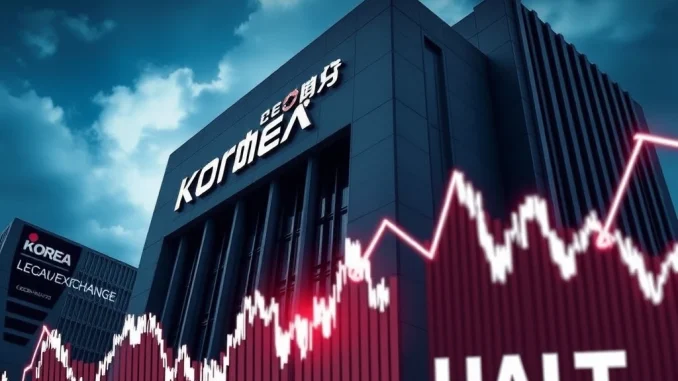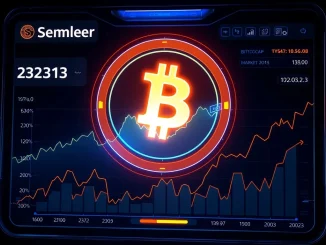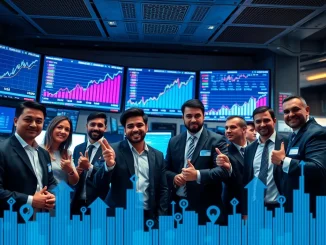
In a surprising turn of events for the South Korean financial markets, the Korea Exchange (KRX) has temporarily suspended trading on the KOSPI, a key indicator of the nation’s economic health. This dramatic intervention, triggered by the activation of a ‘sidecar,’ marks the first such instance in eight months, sending ripples through the investment community. Let’s dive into what exactly happened, why it matters, and what it means for investors and the broader stock market.
What Exactly is a KOSPI Trading Halt and Why Now?
The KOSPI, or Korea Composite Stock Price Index, is the flagship index of the Korea Exchange, representing the overall performance of the Korean stock market. Think of it as the equivalent of the S&P 500 or the FTSE 100 in other major economies. When the KOSPI experiences extreme volatility, the Korea Exchange employs a mechanism called a ‘sidecar’.
A sidecar is essentially a circuit breaker for the entire index. It’s designed to automatically trigger a temporary trading halt when pre-set thresholds are breached, acting as an emergency brake to prevent panic selling or irrational exuberance from spiraling out of control. Here’s a breakdown of what a sidecar entails:
- Sudden Price Fluctuations Trigger: Sidecars are activated when the KOSPI experiences rapid and significant price swings, usually within a short timeframe.
- Temporary Suspension: Upon activation, trading is temporarily halted for a specific period, typically a few minutes. This pause allows market participants to reassess the situation and prevents impulsive decisions driven by fear or hype.
- Cooling-Off Period: The halt provides a crucial ‘cooling-off’ period, giving the market a chance to stabilize and preventing potential cascading effects from extreme volatility.
- Orderly Market Functioning: Ultimately, sidecars are in place to ensure orderly market functioning and protect investors from undue risks associated with excessive market volatility.
News1 reports that this recent activation is the first time in eight months that the Korea Exchange has deemed it necessary to employ this measure. While the specific trigger for this particular trading halt hasn’t been explicitly detailed in the initial reports, it strongly suggests a period of heightened market volatility that prompted the KRX to step in and activate the sidecar mechanism.
Decoding the Sidecar: Your Market Volatility Shield
Imagine a sidecar attached to a motorcycle – it’s there for stability and balance, especially during sharp turns. In the financial world, a ‘sidecar’ mechanism in the stock market serves a similar purpose. It’s a pre-emptive measure designed to curb excessive volatility and maintain market order. But how does it actually work, and why is it beneficial?
Let’s break down the benefits of the sidecar mechanism:
| Benefit | Description |
|---|---|
| Prevents Panic Selling | During times of market stress, fear can drive investors to sell off assets rapidly, leading to further price declines. A sidecar-induced trading halt breaks this cycle, giving investors a moment to pause and reconsider their decisions rationally. |
| Reduces Market Manipulation | Sudden, sharp price movements can sometimes be exploited by malicious actors. By temporarily halting trading, sidecars can disrupt manipulative tactics and promote a fairer trading environment. |
| Enhances Market Stability | The primary goal of a sidecar is to enhance overall market stability. By mitigating extreme volatility, it fosters investor confidence and contributes to a more predictable and reliable market. |
| Protects Investors | Ultimately, sidecars are in place to protect investors, especially retail investors who might be more susceptible to emotional trading decisions during periods of market turmoil. |
However, it’s also important to acknowledge potential challenges associated with trading halts:
- Market Inconvenience: Trading halts can be inconvenient for investors who need immediate access to their funds or want to execute trades quickly.
- Signaling Effect: The activation of a sidecar can sometimes be perceived negatively, signaling to the market that conditions are more turbulent than initially thought, potentially exacerbating anxieties.
- Limited Duration: Sidecars are temporary measures. While they provide a cooling-off period, they are not a long-term solution to underlying market issues.
Korea Exchange’s Proactive Approach to Market Volatility
The Korea Exchange’s (KRX) decision to activate the sidecar demonstrates a proactive approach to managing market volatility. It highlights the exchange’s commitment to maintaining a stable and orderly trading environment. By implementing such mechanisms, the KRX aims to:
- Maintain Investor Confidence: Proactive measures like sidecars can reassure investors that the exchange is actively monitoring and managing market risks.
- Promote Fair Market Practices: By preventing extreme price swings, the KRX fosters a fairer trading environment for all participants.
- Safeguard Market Integrity: Overall, these actions contribute to safeguarding the integrity and reputation of the Korean stock market on the global stage.
The temporary trading halt on the KOSPI serves as a stark reminder of the inherent volatility within financial markets. While the immediate impact may be a temporary disruption, the activation of the sidecar is ultimately a measure designed to protect market participants and ensure the long-term health and stability of the Korean stock market. Investors should view this event not with alarm, but as a testament to the regulatory safeguards in place to navigate periods of uncertainty. As the market digests this event, it will be crucial to monitor further developments and understand the underlying factors that triggered this urgent intervention by the Korea Exchange.



